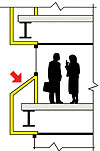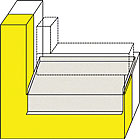
Figure 1: Aesthetic reveals and intersections with flashings.
AESTHETIC REVEALS
When a flashing overlaps an aesthetic reveal, keep in mind that there is a recessed spot in the wall surface at the reveal. An example of this condition is where a parapet flashing laps over a vertical aesthetic reveal. Water can get blown up and under the flashing at this point, even if the amount of overlap itself is supposed to alone keep the water from getting up and under. The deeper and wider the reveal, the more of a problem this can be. Two possible solutions are: Stop the reveal right where the flashing begins, or caulk the opening shut (seeFigure 1).COORDINATION
Sometimes flashings, such as those used at windows (and the windows themselves), need to be installed in a specific sequence. A pre-construction meeting to coordinate installation of wall elements by different trades is thus a good idea. This is especially true when several wall components are right next to each other, such as at windows, flashing, caulking, water-resistant barriers, peel-and-stick tapes and the EIFS itself.PREFAB PANEL PARAPETS
Where parapets extend past the roof line to form a parapet "wall" of sorts, the EIFS often extends up the outside of the building, over the top of the parapet, and down the inside toward the roof, in a continuous mode. If EIFS panels were used to build such a wall, the vertical panel joint would thus go up and over the top of the panel. This joint is very exposed and tends to leak. In this case, flashing is virtually essential to cover the joint, lest the leaky water run right down the open joint cavity and into the window head below.
Figure 2: Yellow is an EIFS panel; red is large sloped sill area.
RECESSED WINDOWS
Sometimes, windows are deeply recessed and EIFS forms the top, bottom and sides of the recess, in a "punched-in" manner. The sill area is often made of EIFS and is sometimes big enough to stand on (seeFigure 2). These large areas tend to wear out prematurely due to their direct exposure to weather (EIFS should not be used on such non-vertical surfaces anyway) and should thus be flashed, although for aesthetic purposes this is often not done.ADHESION TO PAINT
Usually, a wet-applied sealant is used in conjunction with flashing to seal the interface between the flashing, and say, a window frame. Keep in mind that many flashings are painted and sometimes the paints are fluorocarbon-based (Teflon, like non-stick frying pans). These paints require special primers in order for the sealant to adhere.ADHESION TO BASECOAT
Lest I repeat myself, also keep in mind the mantra that the sealant that goes from a flashing to the EIFS should adhere to the basecoat, not to the EIFS finish. This means that somehow the finish should not be installed at this bonding area. This can often mean masking-off the basecoat when the finish is applied, so that there is no finish in the to-be-bonded-to area.THE LOCAL ENVIRONMENT
Make sure to choose a flashing material and a surface coating (if any) that will work where the building is located. I live on the ocean and even quality aluminum and heavily galvanized steel painted flashings start to corrode in a hurry. To combat this, some people use preformed plastic extruded flashings or resort to stainless steel. You can also use marine-grade aluminum (5000 series) that is used "bare" for boat hulls and can withstand salty atmospheres-even direct immersion in ocean water. Along the same lines, make sure that whatever fasteners are used to hold the flashing in place are equally corrosion resistant, lest you get rust stains on your flashing and on the EIFS.HOLES IN FLASHINGS
A common water leak point-of-entry is the screw hole that holds the flashing in place. For example, if a window frame leaks and deposits water into a sill pan flashing under the window, then water might get through the mounting holes. This is especially true with long pieces of aluminum flashing. With aluminum's high coefficient of thermal expansion, the mounting holes can get torn (enlarged) by the movement, allowing water in. The key is simply to put a dab of sealant over each mounting screw or to use screws with integral rubber washers, as are used on metal roofing.
Figure 3: EIFS is in yellow; window perimeter would be caulked (not shown for clarity); Window frame is shown dotted.
DAMS
Sill flashings need end dams (seeFigure 3). This is often overlooked and can be a major source of leak problems. Without end dams, water can run off the end of the flashing and directly into the wall.If you are using flashing under windowsills, you'll also want to have a dam on the inside edge that runs parallel to the length of the flashing. This keeps water from running under the window toward the building interior. The joint, where the side dams meet the back, also need to be sealed shut-usually with caulking.
Often, end dams are made simply by turning up the end of the sheet metal to form a dam. The "poor man's end dam" is simply to caulk the end shut but this is not nearly as effective as using the sheet metal itself. That little seam at the back corner needs to be closed too, with caulking, sticky tapes or soldering.
Similarly, if parapet or balcony wall flashings terminateup againstan EIFS (or other wall), end dams are needed where the flashing terminates to keep water from running off the end and into the wall.
SLOPES
In order for flashings to drain, they must slope at least a little. You especially want to avoid flashings that slope backwards (downhill toward the inside). Dead flat flashings, which may architecturally look cool, tend to not be flat and cause water to "pond" on them. When the water finally gets flushed off, the dirt that has accumulated gets on the EIFS, leaving hard-to-remove stains.EIFS FINISH COATINGS
Most EIFS finish coatings are some type of acrylic, possibly with other resins added to improve performance, such as water shedding ability or dirt pick-up resistance. When EIFS finish coatings get damp for extended periods, such as in standing water on a flat windowsill, they soften slightly. If there is dirt in the water (probably true if the surface has a little slope), the dirt gets absorbedintothe outermost part of the finish. When the finish dries, the dirt remains but is bound into the finish's surface. This can be a real pain when trying to remove. The same problem can occur on vertical surfaces due to water run-off from flashings. Hence it is good design practice to have a drip edge at the end of flashings so the water is deflected away from the finish and not allowed to dribble down onto the EIFS finish.WEEP HOLES
Normally, the interface between the flashing and an adjacent wall component (like a window) is caulked shut. Make sure to leave a small opening (1 inch long by 1/4 inch high) in the caulking at the sill once in a while, so that if water does get behind the caulking, it can weep out. The point where a sill flashing ends-at the end dam-is a good place for a weep, because the flashing will probably not be dead level and the water, if any, will migrate toward one end or the other, and thus needs a place to get out.STRIPPABLE PROTECTIVE COATINGS
Being wet-applied, trowel-applied or sprayed-on materials, EIFS coatings can get onto flashings that have been installed prior to the EIFS. Normally, to avoid getting EIFS materials on the flashings, they are protected with Visqueen and miles of marking tape. You may be aware that there are strippable (removable) clear plastic coatings that can be applied to the painted surfaces and come pre-installed on the flashing, requiring no further effort to keep them in place while they are being installed. Thus, the problem of trying to protect flashings from "EIFS droppings" is dealt with. Usually, these coatings are factory-applied in the sheet metal painting process (called "coil coating"-when the sheet metal is painted as a coil, rather than flat sheets) but sprayable and brushable versions of these coating also exist.Once painted, the strippable coating becomes part of the flashing, just like another layer of paint and stays in place when the flashing is fabricated (shaped into the proper configuration using a bending brake, etc.) and while it is shipped (avoids scratches, water marks, etc.). This type of protective material is left in place during construction and removed when all construction is complete in the area. Make sure to remove it as soon as the job is done, though, as it is a real pain to remove if the sun gets to it (it becomes unstrippable)!
EMBEDDED FLASHING
Don't try to embed ordinary metal flashingwithinthe EIFS lamina. Obviously, it's OK to run flashings upbehindthe EIFS, as this creates the desired water barrier and allows mounting the flashing. I've seen people try to embed flashings (they think it will look better), but it eventually either cracks the coating and/or works its way loose. People imagine that this approach works the same as embedded plastic or metal trim (not flashing) that is designed to be used with EIFS but it doesn't. Slick, flat sheet metal simply doesn't embed well in the thin EIFS lamina.If you're working with a building designer or contractor discussing EIFS flashing issues, the list above-and the previous month's column on this subject-will give you a starting point for addressing common conditions that need attention. In Europe, flashings are the norm, including all sorts of rugged extruded designs of aluminum and even fiberglass, which are designed just for EIFS and that will really keep the water out-built to last but expensive. Flashing is a good thing.
If you read this article, please circle number 344.



Report Abusive Comment